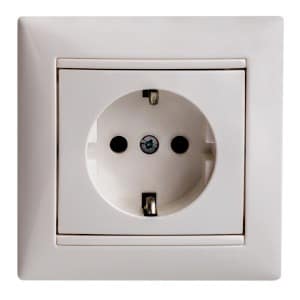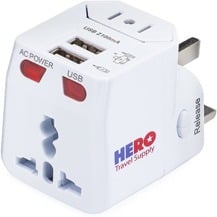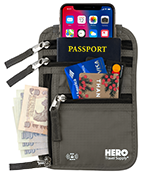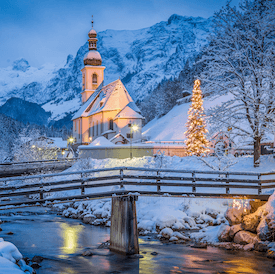Germany attracts tourists both because of its array of attractions and because it’s so easy to travel there. The scenery, architecture, and history could occupy you for a month or more, and with the well-developed public transportation systems and prevalence of English, you won’t have trouble getting around. The only thing necessary for your trip to go smoothly is to pack all the essentials, including the necessary electronic devices and a US to Germany power adapter.
US to Germany Power Adapter: What Plug Do I Need? (2025)
Which power outlets do they use in Germany?

German power outlet
Two different types of electrical sockets are found in Germany: Type C, which has two round holes, and Type F, which has two round holes and two grounding clips. In Berlin and throughout the rest of Germany, the Type F outlets are more common. Both types are used in many countries across Europe, and both can accept any plug type that has only two round pins: Type C, Type E, and Type F.
German sockets are usually set inside a circular indentation in the wall, so plugs need to have a head that’s either round or that’s small enough to fit inside the circle. As in the majority of countries, the electrical grid in Germany operates on a frequency of 50Hz. Its standard voltage is 230V, which means appliances rated to 220V to 240V can be used there without a problem.
What kind of power adapter do I need for Germany?

“What plug do I need for Germany?” is an important question to ask if you’re planning your first trip there.
To use American-made appliances during your trip, you’ll need an adapter with the two-pronged plug type. A US to Germany power adapter has two round pins, as well as a head that’s either rounded or is very small. The round adapters typically have grounding clips, that are designed for Type F outlets – but can still be used with Type C – and are generally safer to use.
We recommend this Universal Adapter that will work throughout Germany and most of Europe.
What’s the electricity and power supply like in Germany?

Germany’s electricity infrastructure is among the best in the world, so power outages are extremely uncommon.
While storms and technical accidents have caused blackouts before, both in Berlin and in more rural areas, you are very unlikely to experience one during your trip.
Do I need a voltage converter for Germany?
Most devices, including laptops, mobile phones, tablets, and cameras are dual voltage and would not require a converter. However, certain American-made devices are only rated to 110V-120V, including hairdryers, and curling irons. If you want to bring one of these items from home, you’ll need a voltage converter in addition to your US to Germany power adapter.
Other Germany Packing List Items
In addition to your US to Germany power adapter, these items will help you pack with intention and expand the possibilities of your getaway. Also, check out our Germany packing list for more inspiration and ideas.
-
1. Neck Wallet / Passport Pouch
Pickpocketing tends to be a problem in touristy areas around the world, and Germany is no exception. To avoid the pickpockets that lurk around tourist attractions in Berlin, Munich, and elsewhere, use a neck wallet. This is the safest place to store your cash, credit cards, and other valuables while you’re out.
![hero neck wallet]()
-
2. Packing Cubes
Packing cubes are the latest innovation to make packing easier and help you stay organized. Instead of putting all your clothes directly in your suitcase or backpack, you’ll fold them into the packing cubes first, and then place the cubes into your bag. Your bag won’t explode when you open it in your hotel room, and it’ll be much easier to find things you’re looking for.
![packing cubes]()
-
3. Virtual Private Network (VPN)
The only websites blocked in Germany are ones involving hate speech, so you don’t need to worry much about Internet censorship. However, using a VPN while you’re there is still a good idea. VPNs will protect your privacy and keep your data and information safe, which is especially important when you’re using a lot of different public Wi-Fi networks, as most of us do when we travel.
![how a vpn works]()
-
4. Lipstick-Sized Charger
If you want to use maps, ride-sharing, or messaging – not to mention the camera on your phone – you’ll need to be able to keep your phone charged throughout the day. Fortunately, all you need is a tiny charger that you can easily keep in your purse or daypack. Just plug it into your phone to juice up the battery while you’re on the move.
![Lipstick-Sized Charger]()
-
5. Windproof Travel Umbrella
Germany can experience a lot of rain anytime of year, therefore it’s best to be prepared. We recommend bringing a compact travel umbrella, so even on those rainy days, you can still be out and about enjoying the sites. This compact travel umbrella comes with a zip case that allows you to store your wet umbrella in your daypack without getting your other belongings wet.
![travel umbrella]()
-
6. Jet Lag Relief Pills
There’s a six-hour time difference between Germany and the East Coast of the U.S. (and nine hours if you’re coming from the West Coast). You don’t want to spend the first few days of your trip waking up at three in the morning and needing naps in the afternoon. Bring some jet lag relief pills to help you adjust to your new time zone quickly and make the most of your time in Germany.
![Jet Lag Relief]()
-
7. Travel Insurance for Germany
Germany is an extremely safe country and not one where you’re especially likely to get in a traffic accident or fall sick from the food. Still, anything can happen, and you don’t want to get stuck paying for medical expenses out of pocket. Your U.S. health insurance most likely won’t cover anything abroad, so it’s well worth buying a travel insurance plan before you leave for Germany. We use TravelInsurance.com to compare plans from all of the top companies to find the best option for our family.
![Travel Insurance for Germany]()
Other FAQs about traveling in Germany
-
1. When to travel to Germany?
The summer months get the most tourists in Germany, which means more crowds and higher prices, but it’s also the rainiest time of year. Spring and fall are less busy and less rainy, so visiting then instead is a win-win. Germany is also an incredibly popular Christmas destination, so things get busy again in December – but it’s a magical time of year to be there.
Tourism in Germany peaks around Oktoberfest as well, in late-September and early-October. Unless you’re a beer enthusiast, you’ll want to steer clear of Munich then (and if you don’t book far in advance, you probably won’t have a choice). Be sure to check current Germany travel advisories before you go.
-
2. What’s the weather like in Germany?
Germany is a fairly temperate country, though winters are on the cold side, and it has less regional variation than might be expected. Due to the country’s geography, the northern city of Hamburg and the southern city of Munich have very similar temperatures. Except for the area right along the coast, though, the south tends to get more precipitation. Across Germany, June to August are the warmest months, but the highs are generally only in the low 80s, and this is also the rainiest time of year. During the winter, temperatures drop below freezing, and snowfall is common, especially in the mountains.
-
3. What to do in Berlin?
Berlin is one of Europe’s most important cities economically and a major destination for travelers. Its key historic sites should be among your first stops, including the Memorial to the Murdered Jews of Europe, the Topography of Terror Museum, and the Allied Museum. No trip to Berlin is complete without seeing what’s left of the Berlin Wall either, and the best place to see it is the East Side Gallery, the longest remaining section.
Take some time to explore the Nikolai Quarter, which is the heart of the old city in Berlin, and get some fresh air at the Bathing Lakes, Tempelhofer Feld, or the Tiergarten. If you’re in Berlin on a Sunday, don’t miss Mauerpark, one of the city’s biggest flea markets.
-
4. Where to go in Germany?
All throughout Germany, you’ll find impressive architecture, breathtaking scenery, and important historical sites. Neuschwanstein (the world’s most famous castle), Cologne’s Cathedral, and the Church of Our Lady in Dresden are all must-see architectural wonders. Outdoorsy travelers will love exploring the Black Forest, Lake Tegernsee, or Kellerwald-Edersee National Park. Germany is also where Christmas markets originated, and if you’re there in December, some of the best are in Nuremberg, Frankfurt, and Cologne.
A winter trip to Germany also means the opportunity to ski in the Bavarian Alps (or at least take in views of the snow-covered peaks). Of course, any trip to Germany should include a visit to the site of at least one of the concentration camps, such as Dachauor Sachsenhausen.
-
5. How to Get Around in Germany?
Germany is very easy to get around, thanks to extensive public transportation throughout the country and within the major towns. High-speed trains connect much of the country and are extremely comfortable and efficient. Long-distance buses also run all throughout Germany; though they’re slower and less comfortable, they can also be considerably cheaper than the trains.
Major cities in Germany have public buses, and most have a train (S-Bahn) and/or subway (U-Bahn) systems as well. True to the stereotype, all forms of German public transportation tend to be extremely punctual.
Renting a car is also an option in Germany, although it’s usually more trouble than it’s worth if you’re spending much time in the cities. Driving Germany’s famed Autobahn is an iconic experience, but given the lack of a speed limit, it’s only recommended if you’re an extremely comfortable driver.











 The summer months get the most tourists in Germany, which means more crowds and higher prices, but it’s also the rainiest time of year. Spring and fall are less busy and less rainy, so visiting then instead is a win-win. Germany is also an incredibly popular Christmas destination, so things get busy again in December – but it’s a magical time of year to be there.
The summer months get the most tourists in Germany, which means more crowds and higher prices, but it’s also the rainiest time of year. Spring and fall are less busy and less rainy, so visiting then instead is a win-win. Germany is also an incredibly popular Christmas destination, so things get busy again in December – but it’s a magical time of year to be there. Germany is a fairly temperate country, though winters are on the cold side, and it has less regional variation than might be expected. Due to the country’s geography, the northern city of Hamburg and the southern city of Munich have very similar temperatures. Except for the area right along the coast, though, the south tends to get more precipitation. Across Germany, June to August are the warmest months, but the highs are generally only in the low 80s, and this is also the rainiest time of year. During the winter, temperatures drop below freezing, and snowfall is common, especially in the mountains.
Germany is a fairly temperate country, though winters are on the cold side, and it has less regional variation than might be expected. Due to the country’s geography, the northern city of Hamburg and the southern city of Munich have very similar temperatures. Except for the area right along the coast, though, the south tends to get more precipitation. Across Germany, June to August are the warmest months, but the highs are generally only in the low 80s, and this is also the rainiest time of year. During the winter, temperatures drop below freezing, and snowfall is common, especially in the mountains. All throughout Germany, you’ll find impressive architecture, breathtaking scenery, and important historical sites. Neuschwanstein (the world’s most famous castle), Cologne’s Cathedral, and the Church of Our Lady in Dresden are all must-see architectural wonders. Outdoorsy travelers will love exploring the Black Forest, Lake Tegernsee, or Kellerwald-Edersee National Park. Germany is also where Christmas markets originated, and if you’re there in December, some of the best are in Nuremberg, Frankfurt, and Cologne.
All throughout Germany, you’ll find impressive architecture, breathtaking scenery, and important historical sites. Neuschwanstein (the world’s most famous castle), Cologne’s Cathedral, and the Church of Our Lady in Dresden are all must-see architectural wonders. Outdoorsy travelers will love exploring the Black Forest, Lake Tegernsee, or Kellerwald-Edersee National Park. Germany is also where Christmas markets originated, and if you’re there in December, some of the best are in Nuremberg, Frankfurt, and Cologne.